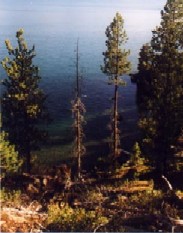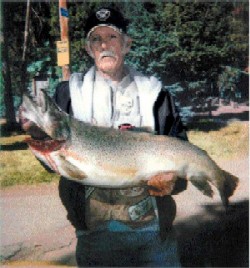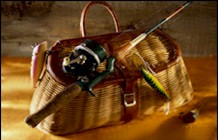|
Information source by
“Fishing Central Oregon-Third Edition”,
1998. Geoff Hill, Brooke Snavely, and Raven
Wing. Sun Publishing, 716 NE 4th
Street, Bend, Oregon |
|
|
|
Paulina
Lake is located within the caldera of Newberry Volcano,
about 25 miles south of Bend, Oregon. The Newberry Crater
(Caldera) encircles the basins of Paulina and
East lake
and it is nearly 5 miles (8 km) in diameter. This
collapsed crater or caldera (caldera in italics) is the
result of more than 500,000 years of volcanic activity.
Neither lake receives water from an inlet stream. Both
lakes rely on rain, snowmelt, and hot springs for water.
Although these lakes are twins and share much in common,
they are not at all identical. diameter. This
collapsed crater or caldera (caldera in italics) is the
result of more than 500,000 years of volcanic activity.
Neither lake receives water from an inlet stream. Both
lakes rely on rain, snowmelt, and hot springs for water.
Although these lakes are twins and share much in common,
they are not at all identical.
Paulina Lake, the larger twin, is the deepest at 250 feet
(76 m). Paulina Creek drains this lake and has chiseled a
narrow gorge through the caldera's west wall creating a
remarkable twin waterfall. Thermal vents and hot springs
along the lake's northeast edge help create a highly
productive ecosystem. The lake fed by snowmelt, hot
springs, and groundwater flows from East Lake. The outlet
stream from the lake is Paulina Creek that flows westward
into the Little Deschutes River. The lake covers an area
of 1531 acres. The average
 depth
of the lake is 163 feet with a maximum depth of 250 feet. depth
of the lake is 163 feet with a maximum depth of 250 feet.
In 2002 in new state record for a brown
trout was caught by Ron Lane of Olancha, California, The
fish weighted 28 pounds and 5 ounces and was caught on a
A.C. Plug. The state record kokanee, a 4 pound 2 ounce
fish captured in 1989, is also from Paulina Lake.
Fishing techniques in the Newberry
Crater revolve around four “fishing seasons”: ice-out,
spring, summer, and fall. These "seasons" will affect
one's trolling speed, leader length, depth, presentation,
and location. Ice-out is the time to pursue big browns by
trolling big plugs. Anglers should try different depths
and various parts of lake. In the spring, kokanee schools
are scattered in 24 to 100 feet of water. Trolling with
bait and jigging are the most popular techniques for
catching kokanee this time of year. Still fishing,
trolling or casting close to the shoreline are the best
bets for the early season. Anglers should concentrate
their efforts close to the bank and within 35 feet of the
surface for the rainbows and browns. Casting lures from
shore in early spring and in the fall is an effective
method for catching large brown trout and rainbows. Change
the speed of the retrieve often, as a stop-and-go
technique is very enticing to large fish. Brown Rooster
Tails with a gold blade are good for catching browns.
Black Rooster Tails, with a silver blade, are good for
rainbows.
|
|
|
|
|
|

|
|





